First Midterm: 8:45 pm on Monday, March 4, 2013
Bring a photo ID. No calculators will be allowed. Bring a pen to the exam: while you may do the midterm in pencil (or crayon), you can only contest grading of problems done in non-erasable ink. Sorry. Locations: The exam will be in various locations around the campus. Where you should go depends on which recitation you are enrolled in. The specific locations are below.
| Lecture 1 | (R01, R02, R03, R05) | ESS001 |
| Lecture 2&3 | (R06, R07, R09, R10, R11) | Harriman 137 |
Material:
The midterm covers sections 5.5, 5.6, 5.7, 5.9, 5.10 and 6.1 of the text
(sections 5.1-5.4 were review and won't be explicitly covered, but knowledge
of the material is relevant).
Doing all of the homework problems
prior to the exam is a very good idea. Doing additional problems
from the text can be helpful.
It is important that you know the basic collection of integrals (which correspond to the derivatives of the standard functions), standard trig identities, etc. A list of these appears on page 358 of your text and inside the front cover (or see here).
Except as noted, you should be able to do all the problems on these practice (and actual) exams from previous semesters. Of course, ability to do all of these is not a guarantee of success on the midterm; the actual exam will cover similar material, not identical problems.
- Midterm from Fall 2011 [Solutions]
- Midterm from Spring 2010 [solutions]
- Midterm 2 for 126, Spring 2010 (Does not include material from sections 5.10 or 6.1) [solutions]
- Practice Exam, Fall 2006 (Note that problems 6 and 7 cover material not on our exam 1). [solutions]
- Midterm, Spring 2004 (Note that problem 4 covers material not on our exam 1). [solutions]
Results:
In general, people did well on this exam. There were a lot more grades of A
than usual; it is unlikely there will be as many A grades on the next
midterm.
But there were also quite a few poor grades.
If you received a grade of less than 90 on this midterm, you are in
danger of needing to retake the course. If you expect to get a grade
of C or higher, you will need to change how you approach this class.
If you are irrecoverably lost, you might want to consider moving to
MAT126 or MAT131 instead; this can be done by
filing this
form with the registrar before 4pm on Friday, March 8.
Below is a graph of the score distribution on the exam.
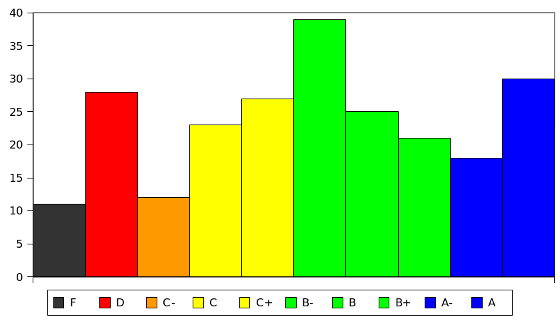
|
|
You can check your grade here.
There were three different versions of the exam. They are the electric version (Solutions), the acoustic verion (Solutions), and the instrumental version (Solutions). Collect 'em all!
Second Midterm: 8:45 pm on Wednesday, April 10, 2013
PLEASE BRING A PEN, as well as a photo ID. While you may do the midterm in pencil (or crayon), you can only contest grading of problems done in non-erasable ink.
Locations: Below are the locations of the rooms for the exam. Note that you will not necessarily be in the same room you were in for the first exam.
| Lecture 1 | (R01, R02, R03, R05) | ESS001 |
| Lecture 2&3 | (R06, R07, R09, R10, R11) | Old Engineering 143 |
Material: The second midterm will cover the material we have covered since the first exam. That is, volumes, arc length, average value, work, (skip pressure, centroids, center of mass), polar coordinates (graphs and area), sequences, and infinite sums (including power series). These topics are covered in the textbook in sections 6.2 through 6.6, appendix H, and sections 8.1 through 8.5.
Keep in mind that ability to do these problems is no
guarantee of success on the midterm; the actual exam will cover similar
material, not identical problems.
Note also that in several previous semesters, the timing of the second exam
and the order in which they did the material differed, so some of the
material may vary.
- Mat132 midterm, Fall 2011 (solutions). Pretty much the same coverage as our exam. Also the same author.
- Mat132 Midterm, Spring 2010 (solutions). This midterm did not cover material on polar coordinates, infinite series or sequences; ours will.
- Practice problems, Fall 2011 (solutions). A bunch of problems on polar coordinates, infinite sequences, infinite sums, and so on that weren't covered on the spring 2010 midterm.
- Problems from URI, Spring 2011 (solutions). These are adapted from a course at URI. It looks weird because I "removed" questions on topics not on our exam.
Results: Below is a graph of the score distribution on the exam.
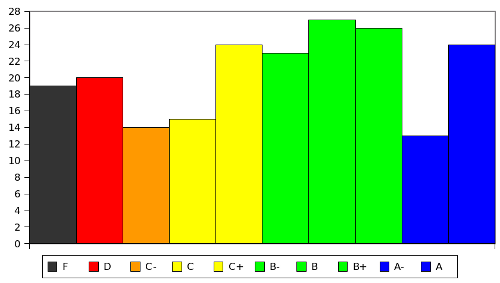
|
|
As you can see from the distribution, quite a few people did well, but sadly there were also quite a few people who did very poorly. There were three people who had no points taken off, but also two people who only earned one point on the entire midterm.
You can check your grade here.
Exam: You can get a copy of the exam, and also the solutions. Only a limited number of these valuable collector's editions will be printed, so they are sure to increase in value. They are available in two delicious flavors: papaya (solutions) and guava (solutions). Order now! Operators are standing by.
Final Exam: 8:00am on Monday, May 20, 2013
The final will be cumulative, covering everything that we have done in the class. However, extra emphasis will be on material since the second midterm.
The final will have two parts.
- The first part will consist of a number of fairly easy questions covering the basic material in the class. If you get at least 75% on this part, you will get a grade of at least C on the final.
- The second part will contain more challenging, multi-step problems and will determine whether you get an A, B, or C on the final. It is unlikely that anyone who can't get a C from the first part will garner enough points on the second part to get a grade better than C, but I guess it could happen. Sometimes pigs can fly, right?
- Final exam from Fall '11 (solutions).
- Sample final, Fall '06 (solutions). [These are more difficult than the final below, but not more difficult than you should be able to do]
- final, spring 2002 (solutions). [All of these problems are fairly straightforward.]
Review/Problem Sessions
- In class, last one or two lectures.
- Thursday, May 16, 2:15-5:00pm, ESS 001 (this is a "problem session." You need to ask questions.)
Results: The performance on the final was, overall, pretty disappointing. But finals are a stressful time, so I guess your brains were not firing on all cylinders. There was only one person who got at least 70 points on part one and didn't also get enough points on part 2 for a C. There were lots of flying pigs after all! Also, it seems that a large fraction of the class can't has reading after all (image courtesy Louise Deon, Fall 2011).
Below is a graph of the score distribution on the exam. This is based on the combination of parts 1 and 2.
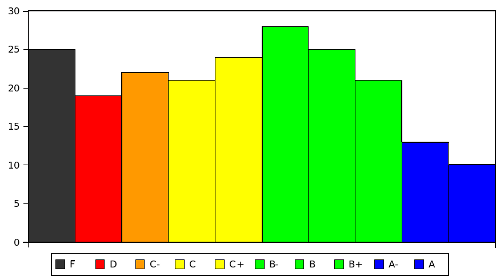
|
|
You can check your grade here.
Course Grade Overall
Based on the final, you'd think that there were more low grades, but overall, a lot of people did OK.The homework grades were pretty high overall, see the graph below. As you can see, a lot of people took advantage of the extra credit; more than 28% of the class had better than 100% on the homework part of the grade. Keep in mind, however, that homework is only worth 15% of the total grade.
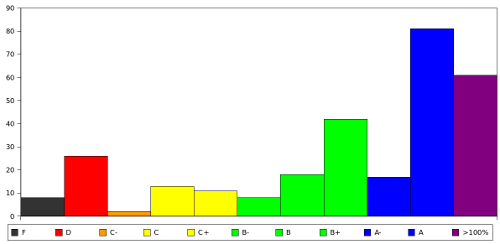 |
And here is the distribution of grades given. Half of the class got a grade of B- or better. The number of A and A- grades was about usual for this class, but there were quite a few more C grades than expected.
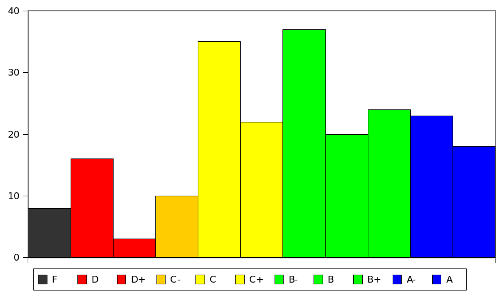 |